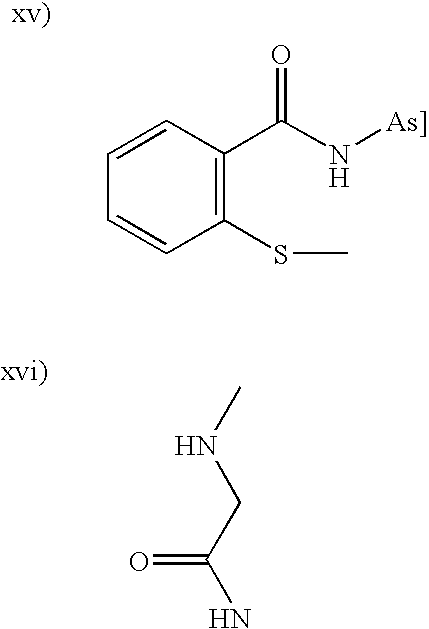Compounds and methods for modulating nonclassical cadherin-mediated functions
a non-classical cadherin and function technology, applied in the field of methods for modulating non-classical cadherin-mediated functions, can solve the problems that the function of non-classical cadherin remains poorly understood at the biological and molecular levels, and achieve the effect of enhancing the function
- Summary
- Abstract
- Description
- Claims
- Application Information
AI Technical Summary
Benefits of technology
Problems solved by technology
Method used
Image
Examples
example 1
Preparation of Representative Modulating Agents
[0307] This Example illustrates the solid phase synthesis of representative peptide modulating agents.
[0308] The peptides were synthesized on a 431A Applied Biosystems peptide synthesizer using p-Hydroxymethylphenoxymethyl polystyrene (HMP) resin and standard Fmoc chemistry. After synthesis and deprotection, the peptides were de-salted on a Sephadex G-10 column and lyophilized. The peptides were analyzed for purity by analytical HPLC, and in each case a single peak was observed. Peptides were made as stock solutions at 10 to 25 mg / mL in dimethylsulfoxide (DMSO) or water and stored at −20° C. before use.
example 2
Disruption of Human Breast Cancer Cell Adhesion
[0309] This Example illustrates the ability of a representative linear peptide comprising an OB-cadherin CAR sequence to disrupt human breast epithelial cell adhesion.
[0310] MDA-MB-231 human breast cancer cells (Lombardi Cancer Research Center, Washington, D.C.) were used in these experiments. They express cadherin-11 (also known as OB-cadherin) but not N-cadherin or E-cadherin. The cells were plated (˜50,000 cells) on glass coverslips and cultured for 24 hours in DMEM containing 5% serum. Peptides (N-Ac-IFVIDDKSG-NH2 (SEQ ID NO:85) and H—IFVIDDKSG-OH (SEQ ID NO:85)) were dissolved in sterile water (10 mg / ml), and 100 μl of each peptide stock solution was added to 1 ml of DMEM containing 5% serum. Control cells had 100 μl of water added to the medium. Cells were monitored by phase contrast microscopy. After 24 hours cells were fixed in formaldehyde. After 24 hours, neither the peptide H-IFVIDDKSG-OH (SEQ ID NO:85) nor water had an eff...
example 3
Disruption of Endothelial Cell Adhesion Using Peptide Modulating Agents with a Cadherin-5 CAR Sequence
[0311] This Example illustrates the ability of a representative linear peptide comprising a cadherin-5 CAR sequence to disrupt endothelial cell adhesion.
[0312] Human umbilical vein endothelial cells were cultured using standard procedures (see Ichikawa et al., Amer. J. Physiol. 273 (Gastrointest. Liver Physiol. 36):3642-6347, 1997). Cells were maintained in EGM (Clonetics, San Diego, Calif.) and used at P2 for all experiments. Endothelial identity was established by Dil-LDL and factor VIII staining.
[0313] The cells were cultured on glass coverslips. Monolayers were exposed to peptides at a concentration of 75 μg / mL for 60 minutes. The cells were then fixed with 95% ethanol for 30 minutes at 4° C., followed by acetone for one minute and left to air dry at room temperature. Primary antibody for VE-cadherin (Immunotech, Marseilles, France; 1:250) was added for one hour at 37° C. Cov...
PUM
| Property | Measurement | Unit |
|---|---|---|
| Composition | aaaaa | aaaaa |
| Size | aaaaa | aaaaa |
| Adhesion strength | aaaaa | aaaaa |
Abstract
Description
Claims
Application Information
 Login to View More
Login to View More - R&D
- Intellectual Property
- Life Sciences
- Materials
- Tech Scout
- Unparalleled Data Quality
- Higher Quality Content
- 60% Fewer Hallucinations
Browse by: Latest US Patents, China's latest patents, Technical Efficacy Thesaurus, Application Domain, Technology Topic, Popular Technical Reports.
© 2025 PatSnap. All rights reserved.Legal|Privacy policy|Modern Slavery Act Transparency Statement|Sitemap|About US| Contact US: help@patsnap.com



